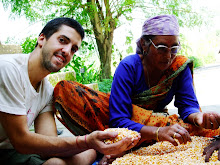Some people have emailed me from the blog and accused me of saying Indian people must stay poor and we must go back to the stone age. This is not at all what I believe. Below is a quick, ad-lib response. Will write more later
Once again, I’m not advocating returning to some idyllic past. Everyone in this world should be able to satisfy their basic needs (healthy food, clean water, adequate home, etc). This year, I have been most excited by the projects which combine modern technology or scientific methods with traditional knowledge. The world has been globalized. Even rural villages in the Andes with no roads and no electricity know about Britney Spears or Obama. In the most remote villages there is usually someone who is passionate about “western” or American ideals. This does not mean we should sit back and just say, “Oh well, globalization has happened.” On the contrary we must work harder than ever to protect the culture and diverse livelihoods which are left. For once we must honor people’s traditional knowledge, but enhance it a way that actually benefits them and empowers people to evolve with the times. In terms of seeds, ideas like participatory plant breeding or community seed banks are spreading at an astounding rate.
I have seen Participatory Plant Breeding (PPB) or Participatory Variety Selection (PVS) in India, Thailand, Ethiopia, and Peru. The basic idea is to connect farmers with scientists in order to develop varieties better suited to local conditions and needs. In the breeding or selection, farmer’s knowledge is considered first, scientists then add empirical thinking and modern methods. Varieties are selected or bred in farmers fields based on the combined efforts of villagers and scientists. Traditional farmers with no chemicals are not called poor or backwards, but instead are honored and respected. As a result, farmers get plants which are more productive and adapted to their land, resistant to pests, diseases, drought, or other challenges. The seeds from these experiments can then be saved and farmers continue to develop and select them based on changing conditions or needs.
Community Seed Banks (CSB’s) is another method which has inspired me greatly all year. They take a diverse range of sizes, shapes, and organization. The basic idea is that CSB’s help to protect and promote local varieties. They ensure farmers have access to seeds which are adapted to their land, needs, and desires. In Garhwal CSB’s help to ensure farmers continue to grow their varieties, which have been grown and saved successfully in these harsh conditions for thousands of year. In Punjab the CSB’s return traditional varieties that have been lost and promote a natural or humane agriculture using the low-input seeds. In Ethiopia an incredible amount of diversity is still connected to local cultures and farming systems. However, farmers face catastrophe and seed shortages as a result of drought, war, erosion, etc. Here, the Community Seed Banks return seeds from the national gene bank, which are good for drought or current challenges. They also develop, protect and spread seeds that grow best for the farmers or those which may disappear during these challenging times. In Canada, CSB’s help home gardeners and organic farmers access seeds that grow well for them, taste exceptional, or a part of their history. From the Potato Park in Peru to the Farmers Freedom Seed bank in Punjab I have been continually inspired by how effective the CSB’s are and how important they are to local communities.
Ranging from small mud huts to large concrete buildings I have visited over 20 community Seed Banks. All CSB’s are organized and run by local community members. They are a dynamic and participatory way of preserving agricultural diversity. Many have other projects associated with them including women’s support groups, micro-lending, compost training, agriculture experiments, marketing, and even organic certification. While there is no exact model to follow, mostly all CSB’s lend out seed at the start of the season free of charge to farmers. Initially these traditional, landrace, or local seeds have been collected and grown out by involved farmers. No money is involved and farmers get quality seeds when they need them (often not the case when they attempt purchasing hybrids). The farmers who received free seed are then expected to pay back the amount of seeds they received plus 10-25% interest at the end of the season. In this way, seeds are multiplied each year and given out to new farmers who want to join. The seeds continue to be grown and farmers share their experiences or suggestions with different methods. Some CSB’s sell the extra seeds and use the money for community projects. Nearly all farmers I spoke with involved said that the seeds they got through the CSB did better than the hybrids and needed fewer inputs. Some said they were happy to taste tomatoes from their childhood again, while others said it was the first year in a decade they had enough wheat to fulfill family needs. There is a lot to tell about community seed banks and I will write more later. What I love about these efforts is that they combine scientist’s desires to stop the loss of agricultural biodiversity with villager’s diverse needs. Instead of forcing a “western” method on to farmers, CSB’s are dynamic and participatory.
Sunday, June 21, 2009
Not about going back, but about going forward. Community Seed Banks, Participatory Breeding, etc
Subscribe to:
Post Comments (Atom)





No comments:
Post a Comment